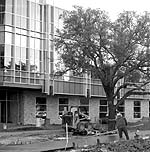Tuesday, January 15, 2002
 |
Tucker
Center lacks funding The William E. and Jean Jones Tucker Technology Center will not have an endowment to cover operating costs when its doors open in April if the university does not raise $6.5 million, administrators said. These costs will be taken up by the university’s general operating budget if an endowment does not exist, placing pressure on the school’s financial resources, said Bronson Davis, vice chancellor of university advancement.
Davis said operating and depreciation costs of new facilities and interest on the growing debt—used to finance TCU’s expansion during the 1990s—has led to “significant jumps in our budget.” “You’re looking at the costs of adding electricity, new systems, more buildings, more people to clean them,” said Davis. Davis said the university’s operating budget is projected to grow $10 million to $15 million a year over the next 10 years. The added costs of operating the Tucker Technology Center contributes to these increases, Davis said. Larger increases in tuition and housing fees may be necessary because income from the university’s endowment has decreased because of the current economic recession, Davis said. “Tuition will probably be increased more this year than the average of the ‘90s,” he said. Davis said depreciation costs have grown from about $4 million to $19 million within the last decade. Depreciation costs occur when the university sets aside money for buildings every year in a fund to make repairs and replace furniture, as needed, Davis said. When new facilities are added, the university has to set aside more money, he said. Chancellor Michael Ferrari said a strain on the budget from the opening of the Tucker Technology Center would only be minor. “We will provide adequate support for staffing and utilities in the 2003 budget,” Ferrari said. “There is no (financial) setback.” The slowing economy and an increase in the expense of the facility caused the university to raise only $18.5 million of the building’s $25 million cost, 20 percent of which is dedicated to its endowment, Davis said. The building’s endowment covers operating costs, such as utilities and maintenance, over the lifetime of the facility, Davis said. “What has happened here is that we funded the construction in fund-raising, but we haven’t funded the endowment,” Davis said. Ferrari said he is optimistic the facility will eventually have an endowment. “(Fund raising) for the project is on-going,” Ferrari said, “I have every reason to believe that we will raise the full amount for the construction and total project costs, (including the endowment).” The facility, which will house the departments of engineering, computer science and mathematics, was originally projected to cost $17 million, officials said. Ferrari said original estimates did not account for needed technology and enrollment growth, and the total was raised to $25 million. “We probably began fund-raising before we were ready,” Davis said. Davis also attributed fund-raising shortcomings to the economy. Two private donors withdrew a total of $2.5 million from the project and the loss of naming rights, which would have contributed half of the project’s cost, both added to the shortcomings. Davis said money from a $30 million bond issued December 2001 for a variety of projects will cover remaining construction expenses if needed. Since donation pledges are usually spread out over a number of years, funds are not available all at once for construction, meaning some bond money would have been used for an interim period regardless if enough funds were raised, Davis said. As of last week, the university had not spent any bond money on the facility but “probably will,” said Carol Campbell, vice chancellor for finance and business. Davis said the price tag of the Tucker Technology Center, which required the largest single fund-raising project in TCU history for one facility, was too much for the university to raise. But, Ferrari said the facility is not overly ambitious. “We are talking about a science building that will serve students and faculty for the next few decades,” Ferrari said. “Had the project been delayed a few years ago, we would now be looking at construction costs of several million more dollars for a new engineering and science building.” Davis said the university is currently asking technology firms for donations, but the poor economy makes the prospects of large donations unlikely. He estimated that only five of the 15 to 20 companies TCU will ask for donations are “healthy.” Construction for the Tucker Technology Center is on schedule and will open April 19, said Jim Weller, associate director of major projects. Students will begin using the building fall 2002. The building is named in honor of former Chancellor William E. Tucker.
Brandon Ortiz |
|||
|
The TCU Daily Skiff © 2002 |
||||


